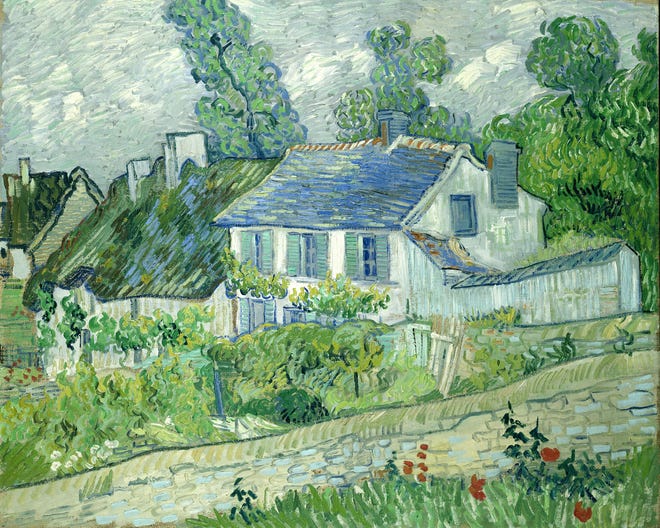
Van Gogh exhibit at the Columbus Museum a must-see experience

The Columbus Museum of Art is paying homage to Vincent Van Gogh and his contemporaries in a spectacular, thoughtful and must-see exhibit.
“Through Vincent’s Eyes: Van Gogh and His Sources” celebrates the tortured Post-Impressionist with 17 of his signature works, interspersed with more than 100 paintings, prints and sculptures by artists who influenced and were admired by van Gogh.
The beautifully installed exhibit places van Gogh works on a deep-blue background, surrounded on white walls by meaningful works created by Van Gogh’s contemporaries.
So, it is possible to do a 15-minute “Louvre” walk-through to find and inspect just the Van Gogh works. But viewers would be doing themselves a huge disservice to go this route; throughout the exhibit there are artistic gems by the likes of Edgar Degas, Paul Gauguin, Edouard Manet, Claude Monet, Camille Pissarro and Henri de Toulouse-Lautrec, to name a few.
More:Visual Arts: Bruce Robinson’s art reflects the layers of meaning behind his passion
In addition, the panels accompanying all the works give relevant and entertaining information.
There are numerous quotes from van Gogh himself, taken largely from his correspondence with his brother and supporter, Theo, that tell what the artist thought of his fellow painters and how they impacted his work.

For instance, as you enter the exhibit, one of the first paintings to strike your eye is van Gogh’s “Roses (1890), a beautiful oil owned by Washington D.C.’s National Gallery of Art. Originally painted pink, the roses faded so that in today’s painting, they’re white. Hung on one side of “Roses” is Henri Fantin-Latour’s “Chrysanthemums of Summer” (1887) and on the other, Manet’s “Peonies” (1864-65). The panel includes the following quote from van Gogh:
“Do you remember that one day at the Hotel Drouot we saw a quite extraordinary Manet, some large pink peonies and their green leaves on a light background? As much in harmony and as much a flower as anything you like, and yet painted in solid, thick impasto …. That’s what I’d call simplicity of technique.”
This kind of placement of works and information makes for a fine viewer experience — enjoying the artistry of van Gogh and his peers in a context-rich presentation.

Of course, there are standout Van Gogh works — not the iconic “Sunflowers” or “Starry Night;” these are not part of this exhibition — but wonderful still lifes, landscapes and portraits, including “Houses at Auvers” and “Les Vessenots in Auvers” (both 1890), “Tarascon Stagecoach” (1888), “Undergrowth with Two Figures” (1890), lithograph “Potato Eaters” (1885) and “Portrait of Dr. Gachet” (1890), van Gogh’s only etching that captures the doctor who attended to him in the final years of his life.
Van Gogh’s love and appreciation for Japanese art — he collected woodblock prints — is reflected with the inclusion of lovely works by Ando Hiroshige (“Sudden
Evening Shower at Ohashi Bridge” from 1857) and Katsushika Hokusai (“Great Wave off Kanagwa” from between 1823-31).
The exhibit is organized in categories such as the “Life in Paris,” “Portraits,”
“Impressionism and After,” “Rustic Life and the Working Class,” “Landscapes” and “Religion.”
Occupying the first floor of the museum’s Walter Wing, the exhibit can be traversed however one likes, but exhibit co-curator David Stark suggests veering off to your left as you enter and first discovering some of van Gogh’s earliest works.

In the more southern portion of the wing, the museum has placed early editions of books van Gogh read (in their original languages because he was multilingual), including Harriet Beecher Stowe’s “Uncle Tom’s Cabin,” Edgar Allan Poe’s “The Raven and Other Poems” and a variety of Charles Dickens’ novels including “Oliver Twist” and “A Tale of Two Cities.” A great admirer of Dickens, van Gogh wrote: “I want to paint what Dickens has done with words.”
That the exhibit has obtained loans from prominent museums throughout the United States and the world is reflected in the van Gogh works and the numerous gems by his contemporaries. Not to be missed are Jean-Francois Millet’s “The Sower” (after 1852), Gauguin’s “Christmas Night” (1902-03) and Jean-Francois Raffaelli’s “The Absinthe Drinkers” (1881).
More:Giving the gift of reading this holiday season? Buying early is wise amid book supply-chain problems
Along with Stark, co-curator for the exhibit was Columbus native Steven Naifeh, author of the new “Van Gogh and the Artists he Loved” and co-author with his late husband Greg White Smith of the biography “Van Gogh: The Life.” The exhibit was organized by the museum along with the Santa Barbara Museum of Art, where it will travel after closing in Columbus.
“Through Vincent’s Eyes” captures the remarkable output of van Gogh during his very short 10 years producing art, and has placed his work in context with that of his peers and the times. Viewers are the beneficiaries of this abundant, intelligently presented collection of art.
At a glance
“Through Vincent’s Eyes: Van Gogh and His Sources” continues through Feb. 6, at the Columbus Museum of Art, 480 E. Broad St. Hours: 10 a.m. to 5 p.m. Tuesdays through Sundays, until 9 p.m. Thursdays. Timed tickets cost $10 plus the regular admission of $18, or $9 for senior citizens, students and ages 4 to 17; free for members and children age 3 and younger. Masks required. Discounted admissions are available Thursday evenings and Sundays. Parking costs $5. Go to www.columbusmuseum.org.
